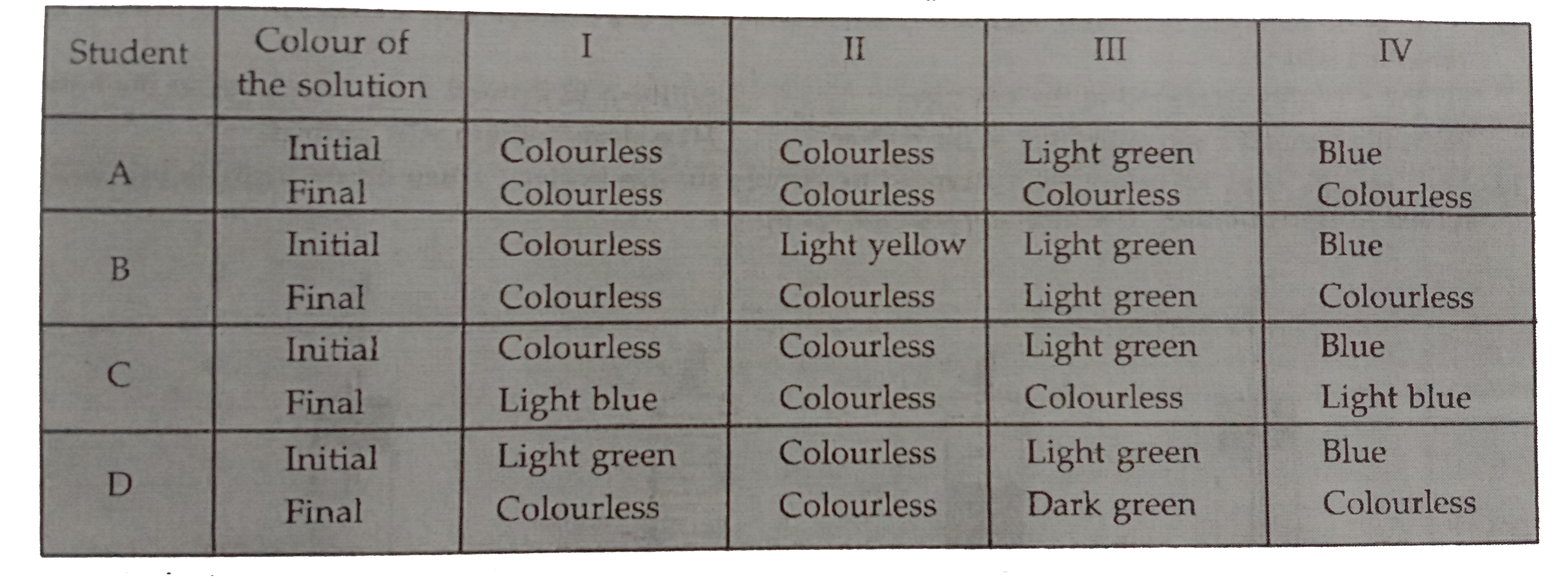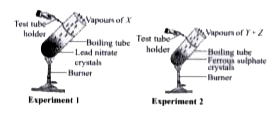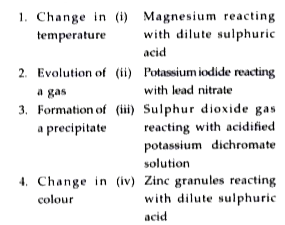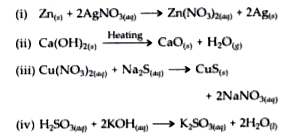Complete Solutions to OLYMPIAD/HOTS CORNER of chapter CHEMICAL REACTIONS AND EQUATIONS of Class 10 book with complete answers and questions
| Class 10 | CHEMISTRY |
| Chapter | CHEMICAL REACTIONS AND EQUATIONS |
| MTG IIT JEE FOUNDATION | OLYMPIAD/HOTS CORNER |
| Number Of Questions | 20 |
| Academic Year | 2023-24 |
When you mix solutions of lead (II) nitrate and potassium iodide.
(i) What is the colour of the precipitate formed ? Name the compound involved.
(ii) Write a balanced chemical equation for the reaction
(iii) Is this a double displacement reaction ?
View Solution`Mg+CuOtoMgO+Cu`
Which of the following is wrong relating to the above reaction?
View SolutionWhich of the following are exothermic processes?
1. Reaction of water with quick lime
2. Dilution of an acid
3. Evaporation of water
4. Sublimation of camphor (crystals)
View SolutionIn the double displacement reaction between aqueous potassium iodide and aqueous lead nitrate, a yellow precipitate of lead iodide is formed. While performing the activity if lead nitrate is not available, which of the following can be used in place of lead nitrate?
View SolutionFour students A,B,C and D noted the initial colour of the solutions in beakers I, II, III and IV. After inserting zinc rods in each solution and leaving it undisturbed for two hours, noted the colour of each solution again.

They recorded their observations in thr form of a table given below:

Which student noted the colour change in all four beakers correctly?
View SolutionFor the given redox reaction :

Identify p, q, r and s.
View SolutionIdentify the type of reaction for each of the following as
Combination - (p), Decomposition - (q), Displacement - ( r), Double displacement - (s), Combustion -(t)
(i) A compound breaks apart into its elements.
(ii) A metal and a non-metal react to form an ionic compound.
(iii) A compound of hydrogen and carbon reacts with oxygen to produce carbon dioxide and water.
(iv) Silver ion from `Ag(NO_(3))` (aq.) forms a precipitate with bromide ion from KBr (aq.).
View SolutionIdentify the correct oxidant and reductant in the following reaction :
`PbS+4H_(2)O_(2)toPbSO_(4)+4H_(2)O`
View SolutionThe given reaction occurs in a car battery when it is used to produce electricity.
`Pb+PbO_(2)+2H_(2)SO_(4)to2PbSO_(4)+2H_(2)O`
Which of the following statements are incorrect about this reaction?
I. Pb is acting as an oxidising agent.
II. `H_(2)SO_(4)` is acting as a reducing agent.
III. The reaction is a precipitation reaction.
IV. `PbO_(2)` oxidises Pb to `PbSO_(4)`.
View SolutionRohit and Mayuri conducted two experiments to study the types of chemical reactions as shown in the given figures.

They recorded their observations as :
I. In experiment 1, yellow residue is left behind while in experiment 2 reddish brown solid is left behind.
II. In both experiments, two different gases were given out.
III. The colourless gas evolved in experiment 1 extinguishes the glowing splint while the gas evolved in experiment 2 turns green solution of acidified `KMnO_(4)` orange.
IV. X is reddish brown gas while gases Y and Z both have burning sulphur smell.
The incorrect observation(s) is/are
View SolutionWhich one of the following reactions is not possible?
View SolutionAddition of `HCl` to an aqueous solution of `Pb(NO_(3))_(2)` gives a
View SolutionThe equation, `Mg_((s))+CuO_((s))toMgO_((s))+Cu_((s))` represents
(A) Decomposition reaction
(B) Displacement reaction
( C) Combination reaction
(D) Double displacement reaction
(E) Redox reaction
View SolutionThe given diagram shows the energy levels of the reactants and products for a particular reaction:

Which of the following processes can be related to the given diagram?
View SolutionThe chemical reaction between quicklime and water is characterised by :
View SolutionThe chemical reactions and their corresponding observable features are matched below. The correct option is

View SolutionA science teacher wrote the following statements about rancidity:
(i) When fats and oils are reduced, they become rancid.
(ii) In chips packet, rancidity is prevented by oxygen.
(iii) Rancidity is prevented by adding antioxidants.
Select the correct option.
View SolutionWhich one is an example of a redox reaction?
View SolutionClassify each of the following reactions.

View SolutionP, Q and R are three metals that undergo chemical reactions as follows:
`P_(2)O_(3)+2QtoQ_(2)O_(3)+2P`
`2P+3ROtoP_(2)O_(3)+3R`
`3RSO_(4)+2QtoQ_(2)(SO_(4))_(3)+3R`
Observe the reactions and arrange the metals in the increasing order of their reactivity.
View Solution
OLYMPIAD/HOTS CORNER questions and complete solutions for chapter CHEMICAL REACTIONS AND EQUATIONS of MTG IIT JEE FOUNDATION of Class 10
All Exercises from MTG IIT JEE FOUNDATION Class 10 CHEMISTRY CHEMICAL REACTIONS AND EQUATIONS
- EXERCISE (ASSERTION & REASON TYPE)
- EXERCISE (COMPREHENSION TYPE)
- EXERCISE (INTEGER/NUMERICAL VALUE TYPE)
- EXERCISE (LONG ANSWER TYPE)
- EXERCISE (MATCH THE FOLLOWING)
- EXERCISE (MULTIPLE CHOICE QUESTIONS) (LEVEL-1)
- EXERCISE (MULTIPLE CHOICE QUESTIONS) (LEVEL-2)
- EXERCISE (SHORT ANSWER TYPE)
- EXERCISE (VERY SHORT ANSWER TYPE)
- ILLUSTRATIONS
- NCERT SECTION
- OLYMPIAD/HOTS CORNER
- SOLVED EXAMPLES